- Arms
- Arms I ca. 85% of ML
- Arms III ca. 145% of ML
- Arms IV ca. 220% of ML
- Largest suckers not globular nor greatly enlarged.
- Large arm suckers with 16 narrow, pointed teeth on distal 2/3 of ring. Distal 10 teeth long, narrow, pointed; lateral teeth short, blunt.
 Click on an image to view larger version & data in a new window
Click on an image to view larger version & data in a new window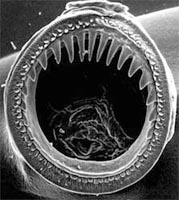
Figure. Oral view of , sucker 2, arm III. of C. veranyi from off Bermuda, western North Atlantic. Photograph by R. Young. A more detailed look at the suckers can be seen here.
- Tentacular clubs
- Club length ca. 50% of ML
- Protective membranes
- Membranes in two distinctive sets of nearly equal length.
- Proximal set broad with x-xx trabeculae (xx-xx% of club length); trabeculae wide, undivided, adjacent and difficult to distinguish (i.e. appear fused in proximal half) from one another.
- Distal set narrow with 19-20 well-separated trabeculae
- Sucker stalks in two distinct parts; stalks of lateral sucker series about 2X longer than those of medial sucker series.
- Suckers with 7-9 pointed teeth over distal 2/3 of ring; central tooth enlarged.
 Click on an image to view larger version & data in a new window
Click on an image to view larger version & data in a new window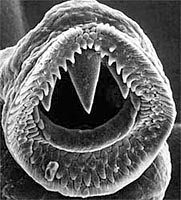
Figure. Tentacular club sucker of C. veranyi from off Bermuda, western North Atlantic. Photograph by R. Young. A more detailed look at the suckers can be seen here.
- Head
- Head length ca. 55% of ML.
- Head length ca. 55% of ML.
- Funnel
- Funnel-locking apparatus with large, bulbus tragus, smaller tubercle-like antitragus.
- Fins
- Fin length ca. 40% of ML.
- Fin width ca. 40% of ML
- Photophores
- Eyeball: lateral series= stripe; intermediate series = 3 (2 posterior:large + small; 1 anterior); medial series = stripe.
- Viscera: Two photophores.
- Club-tip photophore small, without central "line" (discontinuity in structure) and with small papilla.
- Eleven photophores embedded in aboral surface of club.
- Pigmentation
- Club-tip photophore??
- Much club pigment in epithelial cells rather than chromatophore organs.
- Club sucker bases??Sucker stalks pigmented??? with pleats in short, well-defined region.
- Buccal membrane unpigmented???.
- Olfactory organ???
Chiroteuthis veranyi: Description continued
Richard E. Young and Clyde F. E. RoperAbout This Page

University of Hawaii, Honolulu, HI, USA

Smithsonian Institution, Washington, D. C., USA
Page copyright © 1999 and
 Page: Tree of Life
Chiroteuthis veranyi: Description continued
Authored by
Richard E. Young and Clyde F. E. Roper.
The TEXT of this page is licensed under the
Creative Commons Attribution-NonCommercial License - Version 3.0. Note that images and other media
featured on this page are each governed by their own license, and they may or may not be available
for reuse. Click on an image or a media link to access the media data window, which provides the
relevant licensing information. For the general terms and conditions of ToL material reuse and
redistribution, please see the Tree of Life Copyright
Policies.
Page: Tree of Life
Chiroteuthis veranyi: Description continued
Authored by
Richard E. Young and Clyde F. E. Roper.
The TEXT of this page is licensed under the
Creative Commons Attribution-NonCommercial License - Version 3.0. Note that images and other media
featured on this page are each governed by their own license, and they may or may not be available
for reuse. Click on an image or a media link to access the media data window, which provides the
relevant licensing information. For the general terms and conditions of ToL material reuse and
redistribution, please see the Tree of Life Copyright
Policies.
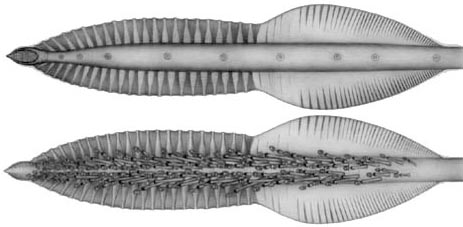
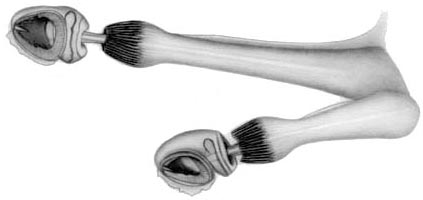

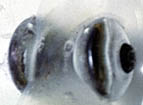
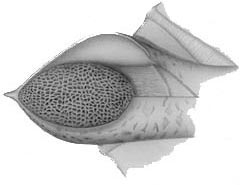


 Go to quick links
Go to quick search
Go to navigation for this section of the ToL site
Go to detailed links for the ToL site
Go to quick links
Go to quick search
Go to navigation for this section of the ToL site
Go to detailed links for the ToL site